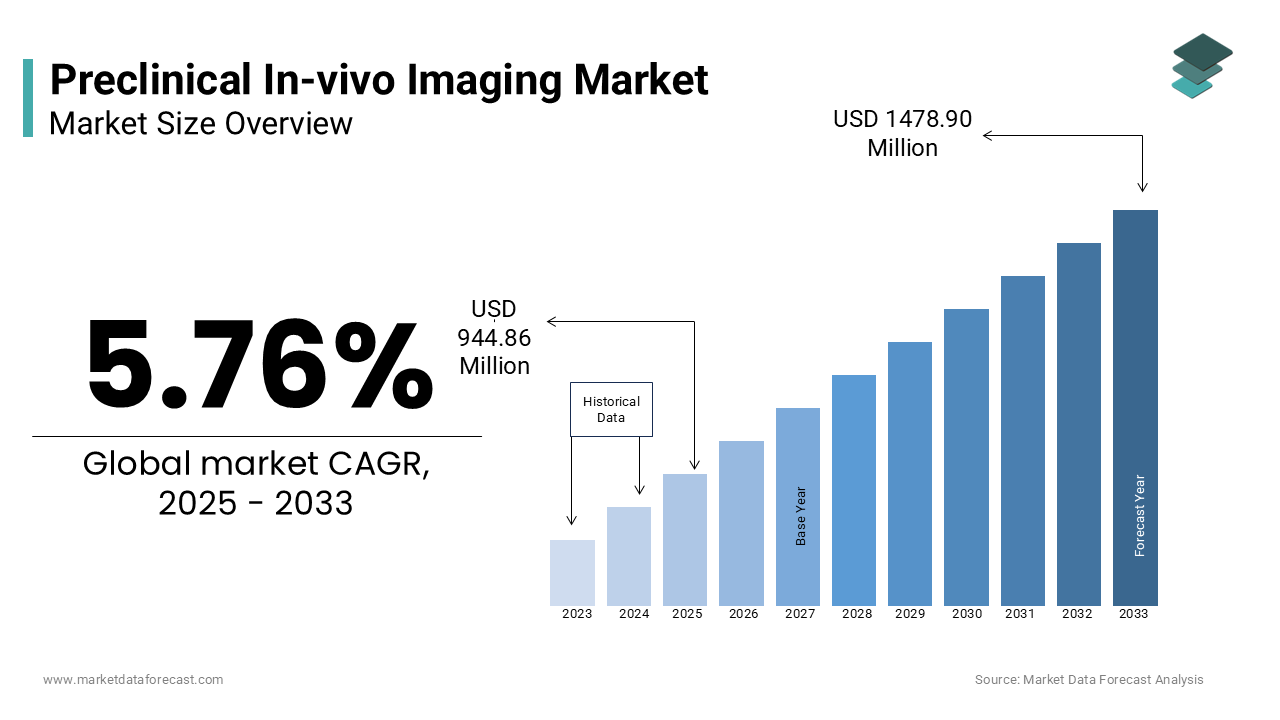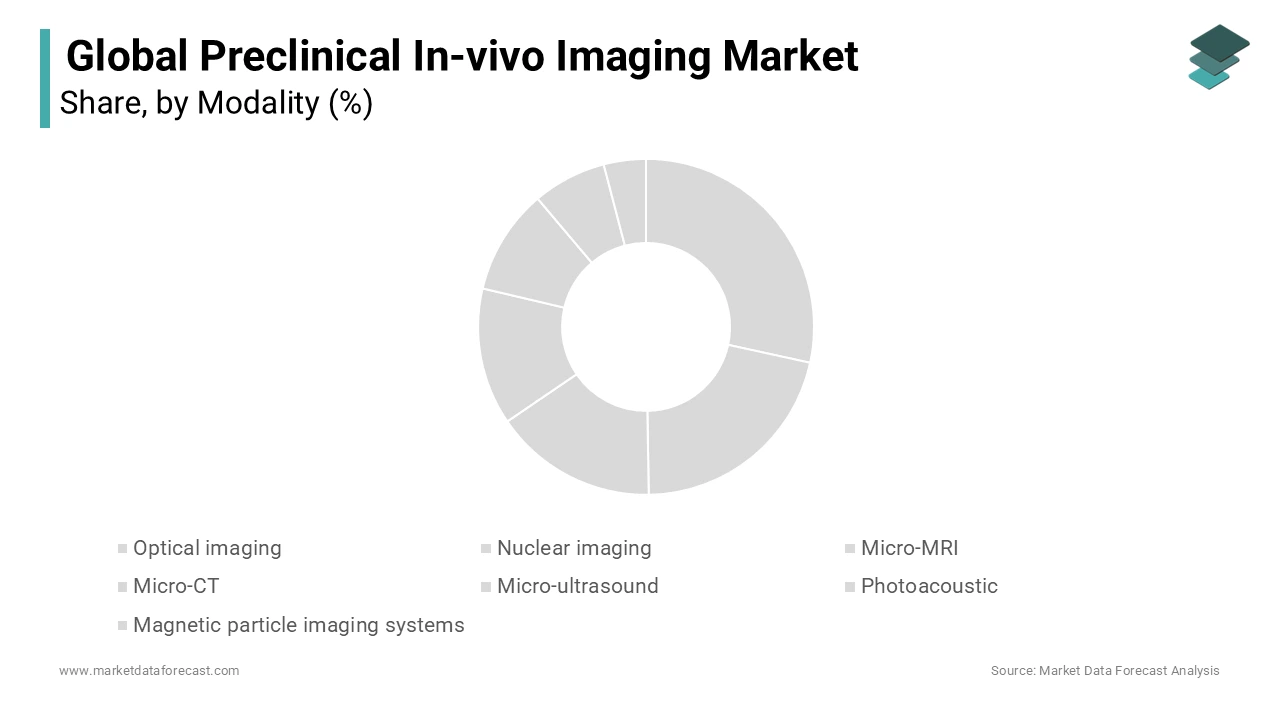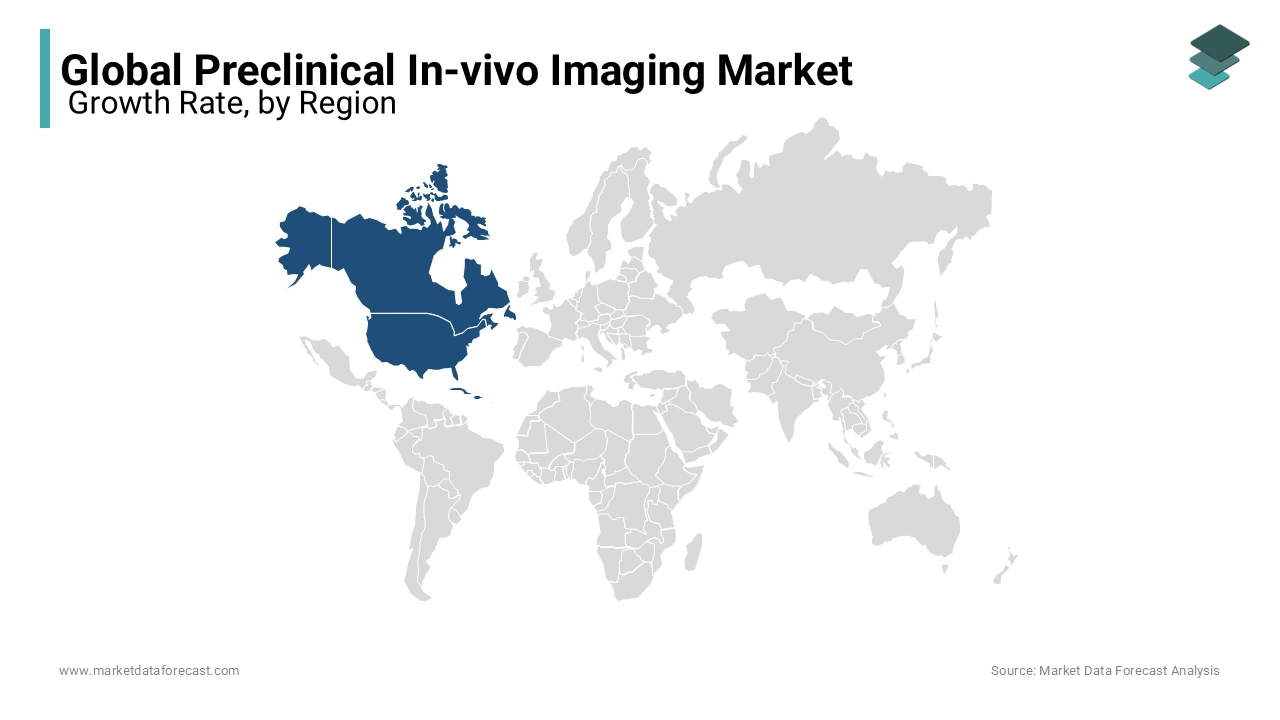Global Preclinical In-vivo Imaging Market Size, Share, Trends & Growth Forecast Report By Modality (Optical Imaging, Nuclear Imaging, Micro-MRI, Micro-CT, Micro-ultrasound, Photoacoustic and Magnetic Particle Imaging Systems), Reagent and Region (North America, Europe, Asia Pacific, Latin America, Middle East & Africa), Industry Analysis From 2025 to 2033
Global Preclinical In-vivo Imaging Market Size
The size of the global preclinical in-vivo imaging market was valued at USD 893.4 million in 2024. The global market size is further forecasted to grow at a CAGR of 5.76% from 2025 to 2033 and be worth 1478.90 million by 2033 from USD 944.86 million in 2025.

MARKET DRIVERS
The importance of the development of molecular imaging in small animals with basic strategies of non-invasive in vivo imaging methods is a primary factor for the preclinical in-vivo imaging market. In recent years, imaging techniques have been prominent in studying and launching potential treatment procedures using small animal models like mice and rats. The non-invasive imaging techniques are highly impactable in learning the treatment effects that reduce the harm to the animals during the research. Researchers can gain huge knowledge over the continuous monitoring of the disease progression and help to develop an innovative treatment procedure in merely less time. Preclinical in-vivo imaging market share is also propelled by the increasing support from the government authorities as it reduces the use of a varied number of animals for specific analysis in research studies. The emergence of the most advanced technologies is ascribed to bolstering the growth rate of the preclinical in-vivo imaging market.
Artificial intelligence, which was integrated into the pharmaceutical and healthcare systems, is ensuring the transformation of the structure of the preclinical in-vivo imaging techniques to another level. AI can provide huge amounts of data required for researchers in very little time. They can perform the work more quickly than usual with the accurate data given by the AI. In addition, high investments from both private and public organizations in the development of new drugs or treatment procedures enhance the growth rate of the preclinical in-vivo imaging market. The growing prevalence of various chronic diseases and the need to launch innovative treatment procedures to combat or reduce the risk of enormously rising diseases are attributed to boosting the size of the market.
MARKET RESTRAINTS
Supply chain disruptions and difficulty in the availability of raw materials are hindering the growth rate of the preclinical in-vivo imaging market. Also, the cost of research activities is incredibly high, and the lack of support from the government in some countries may hamper the market size. Government authorities are taking too long to approve a new drug or any treatment procedures. Authorities are taking stringent actions to promote better and more effective healthcare solutions that are likely to degrade the growth rate of the market slowly. Also, reluctance to adopt new changes and lack of proper knowledge over the collection of data through advanced technology may likely decline the share of the preclinical in-vivo imaging market.
REPORT COVERAGE
|
REPORT METRIC |
DETAILS |
|
Market Size Available |
2024 to 2033 |
|
Base Year |
2024 |
|
Forecast Period |
2025 to 2033 |
|
Segments Covered |
By Modality, Reagent and Region |
|
Various Analyses Covered |
Global, Regional, & Country Level Analysis; Segment-Level Analysis; DROC, PESTLE Analysis; Porter’s Five Forces Analysis; Competitive Landscape; Analyst Overview of Investment Opportunities |
|
Regions Covered |
North America, Europe, APAC, Latin America, Middle East & Africa |
|
Market Leaders Profiled |
Aspect Imaging, Biospace Lab S.A., Bruker Corporation, LI-COR Biosciences, Mediso Ltd., MILabs B.V., MR Solutions Ltd, PerkinElmer, Inc., TriFoil Imaging and FUJIFILM VisualSonics, Inc. |
SEGMENTAL ANALYSIS
By Modality Insights

The micro-ultrasound segment is anticipated to grow with the fastest CAGR over the forecast period. It would be a significant contributor to the global market for preclinical In-vivo imaging. Micro-ultrasound is a smaller ultrasound version with a wider variety of applications, particularly in small animal model research. Some smaller versions of imaging methods improve the techniques ' efficacy. These often decrease the number of animals required for a specific study.
By Reagent Insights
Based on the reagent, the Ultrasound Contrast agents segment is anticipated to dominate the global market owing to their increased application in multiple imaging methods.
REGIONAL ANALYSIS
Regionally, North America holds the largest share of the global preclinical imaging market, followed by Europe. North America dominates the global market given the rapid adoption by end-users of several types of modalities, technological advancement, and increased prevalence of chronic diseases like cancer, cardiovascular disease, and many others.

Factors including rising R&D activities by big pharma and biotech companies in developing nations and increased government funding for the pharmaceutical industry's development are stimulating the growth of the preclinical imaging market in the Asia-Pacific region.
KEY MARKET PLAYERS
Companies like Aspect Imaging, Biospace Lab S.A., Bruker Corporation, LI-COR Biosciences, Mediso Ltd., MILabs B.V., MR Solutions Ltd, PerkinElmer, Inc., TriFoil Imaging, and FUJIFILM VisualSonics, Inc. are currently playing a leading role in the global preclinical in-vivo imaging market.
RECENT HAPPENINGS IN THIS MARKET
- Aspect Imaging, one of the market players in designing and developing compact magnetic resonance systems for preclinical, medical, and industrial applications, unveiled in September 2017 that Quantum Analytics will be its exclusive U.S. distributor for the Industrial product portfolio of Aspect Imaging.
- In mid-2019, Kawasaki Medical University, the research center for state-of-the-art medical science and services in Yokohama, acquired an ultra-high-resolution E-Class U-SPECT6/CT system for preclinical imaging and installed the first MILabs E-Class U-SPECT6/CT system in Japan.
MARKET SEGMENTATION
This research report on the global preclinical in-vivo imaging market has been segmented and sub-segmented based on the modality, reagent, and region.
By Modality
- Optical imaging
- Bioluminescence/fluorescence imaging systems
- Standalone fluorescence imaging systems
- Optical + X-ray/optical + CT imaging systems
- Nuclear imaging
- Micro-PET systems (standalone PET, PET/CT, and PET/MRI)
- Micro-SPECT systems (standalone SPECT, SPECT/CT, and SPECT/MRI)
- Tri-modality (PET/SPECT/CT) imaging systems
- Micro-MRI
- Micro-CT
- Micro-ultrasound
- Photoacoustic
- Magnetic particle imaging systems
By Reagent
- Optical imaging reagents
- Bioluminescent reagents
- Fluorescent imaging reagents
- Nuclear imaging reagents
- Preclinical PET tracers
- Preclinical SPECT probes
- MRI contrast agents
- Ultrasound contrast agents
- CT contrast agents
By Region
- North America
- Europe
- Asia-Pacific
- Latin America
- The Middle East and Africa
Frequently Asked Questions
What is the size of the preclinical in-vivo imaging market?
The global preclinical in-vivo imaging market size was worth USD 893.40 million in 2024.
What are the factors driving the growth of the preclinical in-vivo imaging market?
The increasing demand for in-vivo imaging in preclinical research, advancements in imaging technologies, and growing government funding for research activities are the key factors driving the growth of the preclinical in-vivo imaging market.
What are the challenges faced by the preclinical in-vivo imaging market?
The high cost of imaging systems and equipment, the lack of skilled professionals, and the stringent regulatory framework are some of the challenges faced by the preclinical in-vivo imaging market.
Who are the key players in the preclinical in-vivo imaging market?
Some of the key players in the preclinical in-vivo imaging market include Bruker Corporation, PerkinElmer Inc., FUJIFILM Holdings Corporation, MR Solutions Ltd., and Mediso Ltd.
Related Reports
Access the study in MULTIPLE FORMATS
Purchase options starting from $ 2500
Didn’t find what you’re looking for?
TALK TO OUR ANALYST TEAM
Need something within your budget?
NO WORRIES! WE GOT YOU COVERED!
Call us on: +1 888 702 9696 (U.S Toll Free)
Write to us: [email protected]
